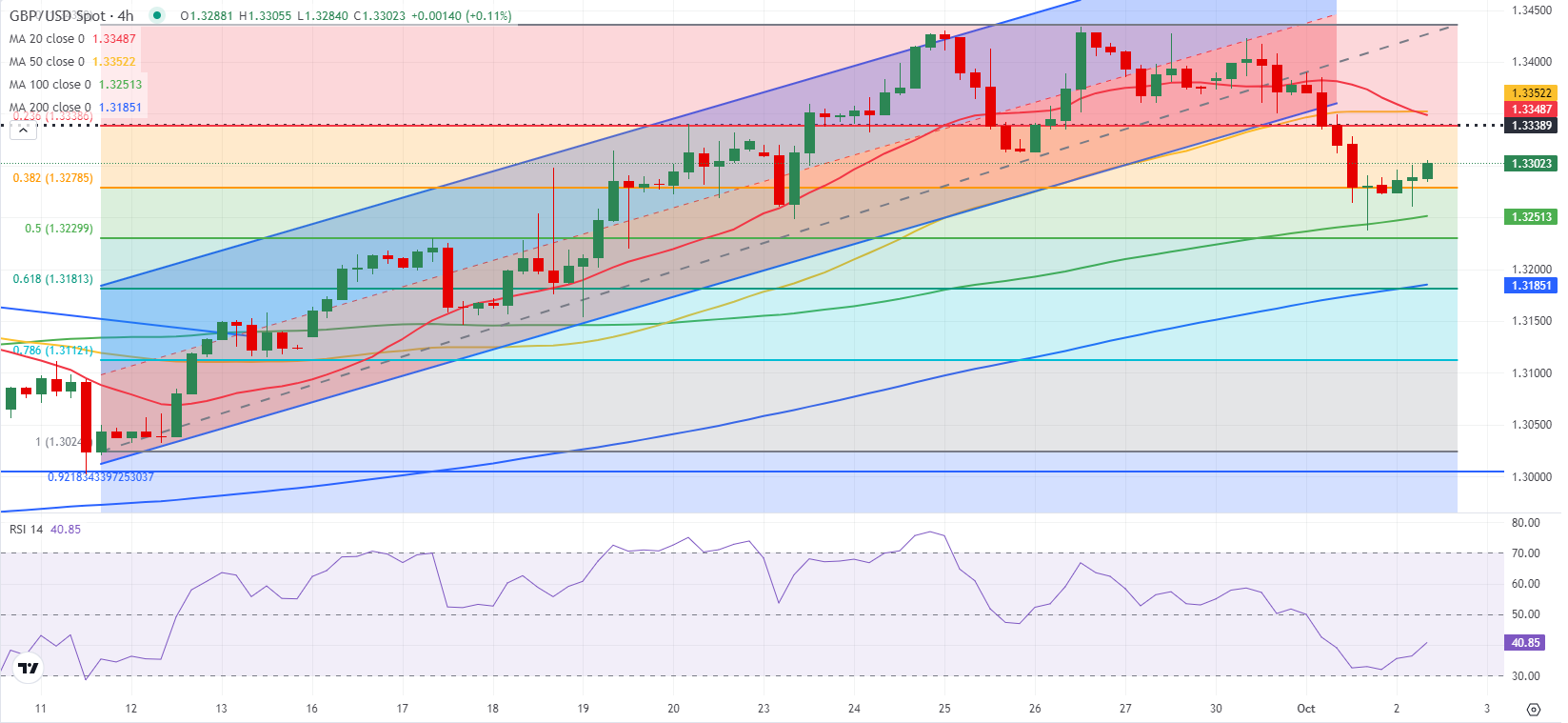- GBP/USD recovers toward 1.3300 following Tuesday's sharp drop.
- The technical outlook remains bearish in the near term.
- ADP Employment Change in the US is forecast to arrive at 120,000 in September.
GBP/USD turned south on Tuesday and lost nearly 0.7% on a daily basis. The pair edges higher toward 1.3300 in the European session on Wednesday but the technical outlook is yet to highlight a buildup of recovery momentum.
British Pound PRICE This week
The table below shows the percentage change of British Pound (GBP) against listed major currencies this week. British Pound was the weakest against the Canadian Dollar.
| USD | EUR | GBP | JPY | CAD | AUD | NZD | CHF | |
|---|---|---|---|---|---|---|---|---|
| USD | 0.76% | 0.54% | 1.37% | -0.22% | 0.00% | 0.68% | 0.48% | |
| EUR | -0.76% | -0.20% | 0.61% | -0.94% | -0.69% | -0.04% | -0.18% | |
| GBP | -0.54% | 0.20% | 0.94% | -0.74% | -0.49% | 0.16% | 0.02% | |
| JPY | -1.37% | -0.61% | -0.94% | -1.51% | -1.40% | -0.64% | -0.80% | |
| CAD | 0.22% | 0.94% | 0.74% | 1.51% | 0.27% | 0.91% | 0.77% | |
| AUD | -0.00% | 0.69% | 0.49% | 1.40% | -0.27% | 0.65% | 0.51% | |
| NZD | -0.68% | 0.04% | -0.16% | 0.64% | -0.91% | -0.65% | -0.16% | |
| CHF | -0.48% | 0.18% | -0.02% | 0.80% | -0.77% | -0.51% | 0.16% |
The heat map shows percentage changes of major currencies against each other. The base currency is picked from the left column, while the quote currency is picked from the top row. For example, if you pick the British Pound from the left column and move along the horizontal line to the US Dollar, the percentage change displayed in the box will represent GBP (base)/USD (quote).
Following a bullish start to the week, the US Dollar (USD) continued to gather strength on Tuesday, forcing GBP/USD to push lower. The risk-averse market atmosphere amid escalating geopolitical tensions helped the USD outperform its rivals. Meanwhile, the US Bureau of Labor Statistics reported that the number of job openings on the last business day of August stood at 8.04, up from 7.71 million in July and above the market expectation of 7.65 million, further supporting the USD.
The Automatic Data Processing (ADP) will publish the private sector employment report later in the day. Investors expect the private sector payrolls to rise by 120,000 following August's 99,000 increase. A disappointing print below 100,000 could cause investors to price in a negative surprise in Friday's Nonfarm Payrolls data and cause the USD to come under selling pressure. On the other hand, a reading above the market forecast could help the USD hold its ground.
Investors will also pay close attention to headlines surrounding the crisis in the Middle East. Israel has vowed to retaliate after Iran has fired about 200 ballistic missiles. In the meantime, the Israeli Defense Forces has reportedly deployed additional troops to Lebanon, prompting the evacuation of 24 villages in Southern Lebanon. A further escalation of geopolitical tensions could allow the USD to benefit from safe-haven flows.
GBP/USD Technical Analysis
The Relative Strength Index (RSI) indicator on the 4-hour chart stays well below 50, suggesting that the recent recovery attempt could be a technical correction rather than the beginning of a reversal.
On the downside, interim support is located at 1.3275 (Fibonacci 38.2% retracement of the latest uptrend) before 1.3250, where the 100-period Simple Moving Average (SMA) is located. A daily close below the latter could attract technical sellers and open the door for another leg lower toward 1.3180 (200-period SMA).
In case GBP/USD stabilizes above 1.3300 (static level), it could face next resistance at 1.3340-1.3350 (Fibonacci 23.6% retracement, 50-period SMA, 20-period SMA) before 1.3400 (round level).
Pound Sterling FAQs
The Pound Sterling (GBP) is the oldest currency in the world (886 AD) and the official currency of the United Kingdom. It is the fourth most traded unit for foreign exchange (FX) in the world, accounting for 12% of all transactions, averaging $630 billion a day, according to 2022 data. Its key trading pairs are GBP/USD, also known as ‘Cable’, which accounts for 11% of FX, GBP/JPY, or the ‘Dragon’ as it is known by traders (3%), and EUR/GBP (2%). The Pound Sterling is issued by the Bank of England (BoE).
The single most important factor influencing the value of the Pound Sterling is monetary policy decided by the Bank of England. The BoE bases its decisions on whether it has achieved its primary goal of “price stability” – a steady inflation rate of around 2%. Its primary tool for achieving this is the adjustment of interest rates. When inflation is too high, the BoE will try to rein it in by raising interest rates, making it more expensive for people and businesses to access credit. This is generally positive for GBP, as higher interest rates make the UK a more attractive place for global investors to park their money. When inflation falls too low it is a sign economic growth is slowing. In this scenario, the BoE will consider lowering interest rates to cheapen credit so businesses will borrow more to invest in growth-generating projects.
Data releases gauge the health of the economy and can impact the value of the Pound Sterling. Indicators such as GDP, Manufacturing and Services PMIs, and employment can all influence the direction of the GBP. A strong economy is good for Sterling. Not only does it attract more foreign investment but it may encourage the BoE to put up interest rates, which will directly strengthen GBP. Otherwise, if economic data is weak, the Pound Sterling is likely to fall.
Another significant data release for the Pound Sterling is the Trade Balance. This indicator measures the difference between what a country earns from its exports and what it spends on imports over a given period. If a country produces highly sought-after exports, its currency will benefit purely from the extra demand created from foreign buyers seeking to purchase these goods. Therefore, a positive net Trade Balance strengthens a currency and vice versa for a negative balance.
Information on these pages contains forward-looking statements that involve risks and uncertainties. Markets and instruments profiled on this page are for informational purposes only and should not in any way come across as a recommendation to buy or sell in these assets. You should do your own thorough research before making any investment decisions. FXStreet does not in any way guarantee that this information is free from mistakes, errors, or material misstatements. It also does not guarantee that this information is of a timely nature. Investing in Open Markets involves a great deal of risk, including the loss of all or a portion of your investment, as well as emotional distress. All risks, losses and costs associated with investing, including total loss of principal, are your responsibility. The views and opinions expressed in this article are those of the authors and do not necessarily reflect the official policy or position of FXStreet nor its advertisers. The author will not be held responsible for information that is found at the end of links posted on this page.
If not otherwise explicitly mentioned in the body of the article, at the time of writing, the author has no position in any stock mentioned in this article and no business relationship with any company mentioned. The author has not received compensation for writing this article, other than from FXStreet.
FXStreet and the author do not provide personalized recommendations. The author makes no representations as to the accuracy, completeness, or suitability of this information. FXStreet and the author will not be liable for any errors, omissions or any losses, injuries or damages arising from this information and its display or use. Errors and omissions excepted.
The author and FXStreet are not registered investment advisors and nothing in this article is intended to be investment advice.
Recommended Content
Editors’ Picks

EUR/USD extends slide toward 1.0300, touches new two-year low
EUR/USD stays under bearish pressure and trades at its lowest level since December 2022 below 1.0350 on Thursday. The US Dollar benefits from the risk-averse market atmosphere and the upbeat Jobless Claims data, causing the pair to stretch lower.

GBP/USD slumps to multi-month lows near 1.2400 on broad USD strength
Following an earlier recovery attempt, GBP/USD reversed its direction and declined to its weakest level in nearly eight months near 1.2400. The renewed US Dollar (USD) strength on worsening risk mood weighs on the pair as trading conditions normalize after the New Year break.

Gold benefits from risk aversion, climbs above $2,640
Gold gathers recovery momentum and trades at a two-week-high above $2,640 in the early American session on Thursday. The precious metal benefits from the sour market mood and the pullback seen in the US Treasury bond yields.

XRP rockets 11% as Bitcoin starts New Year with bullish bang
Crypto majors zoomed higher in the past 24 hours as the market entered a widely expected bullish year, with Bitcoin inching above $95,000 to shake off losses from last week. XRP surged 11% to lead growth among majors as of Thursday, led by $1.3 billion worth of trading volumes on Korea-focused exchange UpBit.

Three Fundamentals: Year-end flows, Jobless Claims and ISM Manufacturing PMI stand out Premium
Money managers may adjust their portfolios ahead of the year-end. Weekly US Jobless Claims serve as the first meaningful release in 2025. The ISM Manufacturing PMI provides an initial indication ahead of Nonfarm Payrolls.

Best Forex Brokers with Low Spreads
VERIFIED Low spreads are crucial for reducing trading costs. Explore top Forex brokers offering competitive spreads and high leverage. Compare options for EUR/USD, GBP/USD, USD/JPY, and Gold.
